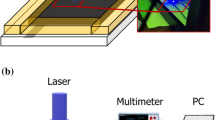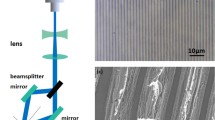Abstract
In this study, laser-induced graphene oxide (LIGO) was synthesized through a facile liquid-based process involving the introduction of deionized (DI) water onto polyimide (PI) film and subsequent direct laser irradiation using a CO2 laser (λ = 10.6 μm). The synthesized LIGO was then evaluated as a sensing material for monitoring changes in humidity levels. The synthesis conditions were optimized by precisely controlling the laser scribing speed, leading to the synthesis of LIGO with different structural characteristics and varying oxygen contents. The increased number of oxygen-containing functional groups contributed to the hydrophilic properties of LIGO, resulting in a superior humidity sensing capabilities compared with laser-induced graphene (LIG). The LIGO-based sensors outperformed LIG-based sensors, demonstrating approximately tenfold higher sensing responsivity when detecting changes at each humidity level, along with 1.25 to 1.75 times faster response/recovery times, making LIGO-based sensors more promising for humidity-monitoring applications. This study demonstrated laser ablation in a renewable and natural precursor as an eco-friendly and energy-efficient approach to directly synthesize LIGO with controllable oxidation levels.
Graphical abstract








Similar content being viewed by others
Data availability
All relevant data are available from the authors upon reasonable request.
Abbreviations
- GO:
-
Graphene oxide
- LIG:
-
Laser-induced graphene
- LIGO:
-
Laser-induced graphene oxide
- PI:
-
Polyimide
- sccm:
-
Standard cubic centimeter per minute
- RH:
-
Relative humidity
- FLG:
-
Few-layered graphene
- rGO:
-
Reduced graphene oxide
- LS:
-
Lignosulfonate
- PAA:
-
Polyacrylic acid
- PDDA:
-
Poly(diallylimethyammonium chloride)
- PEI:
-
Polyethyleneimine (PEI)
- Nps:
-
Nanoparticles
- ID :
-
Intensity of the D peak
- IG :
-
Intensity of the G peak
- \(\Delta {\varvec{R}}\) :
-
Difference between the baseline electrical resistance and the real-time electrical resistance
- \({{\varvec{R}}}_{0}\) :
-
Baseline electrical resistance, measured at 10% humidity levels before the introduction of the target humidity
- \({{\varvec{R}}}_{{\varvec{h}}}\) :
-
Real-time electrical resistance, measured after the introduction of target humidity
References
Beniwal A et al (2023) Screen-printed graphene-carbon ink based disposable humidity sensor with wireless communication. Sens Actuat B Chem 374:132731. https://doi.org/10.1016/j.snb.2022.132731
Wang X et al (2021) An ultrafast-response and flexible humidity sensor for human respiration monitoring and noncontact safety warning. Microsyst Nanoeng 7:99. https://doi.org/10.1038/s41378-021-00324-4
Xie B et al (2023) High-Performance flexible humidity sensor based on MoOx nanoparticle films for monitoring human respiration and non-contact sensing. ACS Appl Nano Mater 6:7011–7021. https://doi.org/10.1021/acsanm.3c01131
Rajendran S, Bhunia SK (2023) Carbon dots decorated graphitic carbon nitride as a practical and flexible metal-free nanosensor for breath humidity monitoring. Carbon Lett. https://doi.org/10.1007/s42823-023-00624-x
Liu J, Tang J, Gooding JJ (2012) Strategies for chemical modification of graphene and applications of chemically modified graphene. J Mater Chem 22:12435–12452. https://doi.org/10.1039/C2JM31218B
Si C, Sun Z, Liu F (2016) Strain engineering of graphene: a review. Nanoscale 8:3207–3217. https://doi.org/10.1039/C5NR07755A
Ruan J et al (2021) Constructing 1D/2D interwoven carbonous matrix to enable high-efficiency sulfur immobilization in Li-S battery. Energy Mater 1: 100018. https://doi.org/10.20517/energymater.2021.22
Li T et al (2023) Two-dimensional nitrogen and phosphorus co-doped mesoporous carbon-graphene nanosheets anode for high-performance potassium-ion capacitor. Energy Mater 3: 300018. https://doi.org/10.20517/energymater.2022.93
Wei Z et al (2010) Nanoscale tunable reduction of graphene oxide for graphene electronics. Science 328:1373–1376. https://doi.org/10.1126/science.1188119
Xia C et al (2023) Spotlighting the boosted energy storage capacity of CoFe2O4/Graphene nanoribbons: a promising positive electrode material for high-energy-density asymmetric supercapacitor. Energy 270:126914. https://doi.org/10.1016/j.energy.2023.126914
Du B et al (2023) Phase change materials microcapsules reinforced with graphene oxide for energy storage technology. Energy Mater 3: 300026. https://doi.org/10.20517/energymater.2023.04
Vasseghian Y et al (2022) Spotlighting graphene-based catalysts for the mitigation of environmentally hazardous pollutants to cleaner production: a review. J Clean Prod 365:132702. https://doi.org/10.1016/j.jclepro.2022.132702
Yan Y et al (2021) A recent trend: application of graphene in catalysis. Carbon Lett 31:177–199. https://doi.org/10.1007/s42823-020-00200-7
Karimi H et al (2016) An analytical approach to calculate the charge density of biofunctionalized graphene layer enhanced by artificial neural networks. Plasmonics 11:95–102. https://doi.org/10.1007/s11468-015-9998-y
Abdelbasset WK et al (2022) Comparison and evaluation of the performance of graphene-based biosensors. Carbon Lett 32:927–951. https://doi.org/10.1007/s42823-022-00338-6
Borini S et al (2013) Ultrafast graphene oxide humidity sensors. ACS Nano 7:11166–11173. https://doi.org/10.1021/nn404889b
Bi H et al (2013) Ultrahigh humidity sensitivity of graphene oxide. Sci Rep 3:2714. https://doi.org/10.1038/srep02714
Morozov S et al (2008) Giant intrinsic carrier mobilities in graphene and its bilayer. Phys Rev Lett 100:016602. https://doi.org/10.1103/PhysRevLett.100.016602
Li X et al (2014) Ultrahigh specific surface area of graphene for eliminating subcooling of water. Appl Energy 130:824–829. https://doi.org/10.1016/j.apenergy.2014.02.032
Lin Y-M, Avouris P (2008) Strong suppression of electrical noise in bilayer graphene nanodevices. Nano Lett 8:2119–2125. https://doi.org/10.1021/nl080241l
Zieba W et al (2022) High-Surface-Area Graphene Oxide for Next-Generation Energy Storage Applications. ACS Appl Nano Mater 5:18448–18461. https://doi.org/10.1021/acsanm.2c04281
Tien HN et al (2013) Synthesis of a highly conductive and large surface area graphene oxide hydrogel and its use in a supercapacitor. J Mater Chem A 1:208–211. https://doi.org/10.1039/C2TA00444E
Ganesh B, Isloor AM, Ismail AF (2013) Enhanced hydrophilicity and salt rejection study of graphene oxide-polysulfone mixed matrix membrane. Desalination 313:199–207. https://doi.org/10.1016/j.desal.2012.11.037
Paredes J, Villar-Rodil S, Martínez-Alonso A, Tascon JM (2008) Graphene oxide dispersions in organic solvents. Langmuir 24:10560–10564. https://doi.org/10.1021/la801744a
Feicht P, Eigler S (2018) Defects in graphene oxide as structural motifs. ChemNanoMat 4:244–252. https://doi.org/10.1002/cnma.201700357
Lian B et al (2018) Extraordinary water adsorption characteristics of graphene oxide. Chem Sci 9:5106–5111. https://doi.org/10.1039/C8SC00545A
Lerf A et al (2006) Hydration behavior and dynamics of water molecules in graphite oxide. J Phys Chem Solids 67:1106–1110. https://doi.org/10.1016/j.jpcs.2006.01.031
Hummers WS, Offeman RE (1958) Preparation of Graphitic Oxide. J Am Chem Soc 80:1339. https://doi.org/10.1021/ja01539a017
Lin J et al (2014) Laser-induced porous graphene films from commercial polymers. Nat Commun 5:5714. https://doi.org/10.1038/ncomms6714
Ye R, James DK, Tour JM (2019) Laser-induced graphene: from discovery to translation. Adv Mater 31:1803621. https://doi.org/10.1002/adma.201803621
Zhang J et al (2018) Oxidized laser-induced graphene for efficient oxygen electrocatalysis. Adv Mater 30:1707319. https://doi.org/10.1002/adma.201707319
Duy LX et al (2018) Laser-induced graphene fibers. Carbon 126:472–479. https://doi.org/10.1016/j.carbon.2017.10.036
Le TSD et al (2022) Recent advances in laser-induced graphene: mechanism, fabrication, properties, and applications in flexible electronics. Adv Func Mater 32:2205158. https://doi.org/10.1002/adfm.202205158
Chung C et al (2010) Water-assisted CO2 laser ablated glass and modified thermal bonding for capillary-driven bio-fluidic application. Biomed Microdevice 12:107–114. https://doi.org/10.1007/s10544-009-9365-x
Kang HW, Welch AJ (2007) Effect of liquid thickness on laser ablation efficiency. J Appl Phys 101:083101. https://doi.org/10.1063/1.2715746
Chin S, Lagacé S (1996) Generation of H2, O2, and H2O2 from water by the use of intense femtosecond laser pulses and the possibility of laser sterilization. Appl Opt 35:907–911. https://doi.org/10.1364/AO.35.000907
López-Díaz D, Lopez Holgado M, García-Fierro JL, Velázquez MM (2017) Evolution of the Raman spectrum with the chemical composition of graphene oxide. J Phys Chem C 121:20489–20497. https://doi.org/10.1021/acs.jpcc.7b06236
Kaniyoor A, Ramaprabhu S (2012) A Raman spectroscopic investigation of graphite oxide derived graphene. AIP Adv 2:032183. https://doi.org/10.1063/1.4756995
Shimodaira N, Masui A (2002) Raman spectroscopic investigations of activated carbon materials. J Appl Phys 92:902–909. https://doi.org/10.1063/1.1487434
Gupta B et al (2017) Role of oxygen functional groups in reduced graphene oxide for lubrication. Sci Rep 7:45030. https://doi.org/10.1038/srep45030
Yi J et al (2019) Facile patterning of laser-induced graphene with tailored li nucleation kinetics for stable lithium-metal batteries. Adv Energy Mater 9:1901796. https://doi.org/10.1002/aenm.201901796
Wan Z et al (2020) Laser induced self-N-doped porous graphene as an electrochemical biosensor for femtomolar miRNA detection. Carbon 163:385–394. https://doi.org/10.1016/j.carbon.2020.03.043
Phuc NT et al (2023) Optimization of the eco-friendly synthesis of graphene oxide from graphite using Plackett-Burman and Box-Behnken models for industrial production orientation. Carbon Lett 33:489–500. https://doi.org/10.1007/s42823-022-00439-2
Ossonon BD, Bélanger D (2017) Synthesis and characterization of sulfophenyl-functionalized reduced graphene oxide sheets. RSC Adv 7:27224–27234. https://doi.org/10.1039/C6RA28311J
Nugba BE, El-Moneim A, Mousa NO, Osman A (2023) A nonenzymatic laser-induced flexible amperometric graphene electrode for glucose detection in saliva. Carbon Lett 33:1767–1780. https://doi.org/10.1007/s42823-023-00489-0
Wang F et al (2018) Graphitized hierarchically porous carbon nanosheets derived from bakelite induced by high-repetition picosecond laser. Appl Surf Sci 450:155–163. https://doi.org/10.1016/j.apsusc.2018.04.130
Choi K-H et al (2020) Triboelectric effect of surface morphology controlled laser induced graphene. J Mater Chem A 8:19822–19832. https://doi.org/10.1039/D0TA05806H
Hyeong SK et al (2022) Compacted laser-induced graphene with bamboo-like carbon nanotubes for transformable capacitive energy storage electrodes. Adv Mater Technol 7:2101105. https://doi.org/10.1002/admt.202101105
Inagaki M et al (1989) Carbonization of polyimide film “Kapton.” Carbon 27:253–257. https://doi.org/10.1016/0008-6223(89)90131-0
Krishnamoorthy K, Veerapandian M, Yun K, Kim S-J (2013) The chemical and structural analysis of graphene oxide with different degrees of oxidation. Carbon 53:38–49. https://doi.org/10.1016/j.carbon.2012.10.013
Venugopal G, Krishnamoorthy K, Mohan R, Kim S-J (2012) An investigation of the electrical transport properties of graphene-oxide thin films. Mater Chem Phys 132:29–33. https://doi.org/10.1016/j.matchemphys.2011.10.040
Ricciardella F et al (2020) Low-humidity sensing properties of multi-layered graphene grown by chemical vapor deposition. Sensors 20:3174. https://doi.org/10.3390/s20113174
Phan D-T, Chung G-S (2015) Effects of rapid thermal annealing on humidity sensor based on graphene oxide thin films. Sens Actuat B Chem 220:1050–1055. https://doi.org/10.1016/j.snb.2015.06.055
Chen C et al (2018) Humidity sensor based on reduced graphene oxide/lignosulfonate composite thin-film. Sens Actuat B Chem 255:1569–1576. https://doi.org/10.1016/j.snb.2017.08.168
Lee J, Cho D, Jeong Y (2013) A resistive-type sensor based on flexible multi-walled carbon nanotubes and polyacrylic acid composite films. Solid-State Electron 87:80–84. https://doi.org/10.1016/j.sse.2013.05.001
Zhao H et al (2017) Drawn on paper: a reproducible humidity sensitive device by handwriting. ACS Appl Mater Interfaces 9:28002–28009. https://doi.org/10.1021/acsami.7b05181
Zhang D, Tong J, Xia B (2014) Humidity-sensing properties of chemically reduced graphene oxide/polymer nanocomposite film sensor based on layer-by-layer nano self-assembly. Sens Actuat B Chem 197:66–72. https://doi.org/10.1016/j.snb.2014.02.078
Zhang R, Peng B, Yuan Y (2018) Flexible printed humidity sensor based on poly (3, 4-ethylenedioxythiophene)/reduced graphene oxide/Au nanoparticles with high performance. Compos Sci Technol 168:118–125. https://doi.org/10.1016/j.compscitech.2018.09.013
Zhu P et al (2019) Flexible and highly sensitive humidity sensor based on cellulose nanofibers and carbon nanotube composite film. Langmuir 35:4834–4842. https://doi.org/10.1021/acs.langmuir.8b04259
Acknowledgements
This work was financially supported by a National Research Foundation of Korea (NRF) grant funded by the Korean government (Grant no. 2022R1A4A1034312, 2022R1F1A1072339 and 2022M3H4A4086049).
Author information
Authors and Affiliations
Corresponding authors
Ethics declarations
Conflict of interest
The authors declare no competing interests.
Additional information
Publisher's Note
Springer Nature remains neutral with regard to jurisdictional claims in published maps and institutional affiliations.
Supplementary Information
Below is the link to the electronic supplementary material.
Rights and permissions
Springer Nature or its licensor (e.g. a society or other partner) holds exclusive rights to this article under a publishing agreement with the author(s) or other rightsholder(s); author self-archiving of the accepted manuscript version of this article is solely governed by the terms of such publishing agreement and applicable law.
About this article
Cite this article
An, J.W., Hyeong, SK., Kim, K.M. et al. Facile synthesis of laser-induced graphene oxide and its humidity sensing properties. Carbon Lett. 34, 1173–1185 (2024). https://doi.org/10.1007/s42823-023-00672-3
Received:
Revised:
Accepted:
Published:
Issue Date:
DOI: https://doi.org/10.1007/s42823-023-00672-3




